ATX Specification
Version 2.2
�
ATX Specification - Version 2.2
IMPORTANT INFORMATION AND DISCLAIMERS
1.
INTEL CORPORATION MAKES NO WARRANTIES WITH REGARD TO THIS ATX
SPECIFICATION (“SPECIFICATION”), AND IN PARTICULAR DOES NOT WARRANT OR REPRESENT
THAT THIS SPECIFICATION OR ANY PRODUCTS MADE IN CONFORMANCE WITH IT WILL WORK
IN THE INTENDED MANNER. NOR DOES INTEL ASSUME RESPONSIBILITY FOR ANY ERRORS
THAT THE SPECIFICATION MAY CONTAIN OR HAVE ANY LIABILITIES OR OBLIGATIONS FOR
DAMAGES INCLUDING, BUT NOT LIMITED TO, SPECIAL, INCIDENTAL, INDIRECT, PUNITIVE, OR
CONSEQUENTIAL DAMAGES WHETHER ARISING FROM OR IN CONNECTION WITH THE USE OF
THIS SPECIFICATION IN ANY WAY.
2. NO REPRESENTATIONS OR WARRANTIES ARE MADE THAT ANY PRODUCT BASED IN
WHOLE OR IN PART ON THE ABOVE SPECIFICATION WILL BE FREE FROM DEFECTS OR SAFE
FOR USE FOR ITS INTENDED PURPOSE. ANY PERSON MAKING, USING OR SELLING SUCH
PRODUCT DOES SO AT HIS OR HER OWN RISK.
IS, AND THAT
IS PROVIDED AS
3.
THE USER OF THIS SPECIFICATION HEREBY EXPRESSLY ACKNOWLEDGES THAT THE
SPECIFICATION
INTEL CORPORATION MAKES NO
REPRESENTATIONS, EXTENDS NO WARRANTIES OF ANY KIND, EITHER EXPRESS OR IMPLIED,
ORAL OR WRITTEN, INCLUDING ANY WARRANTY OF MERCHANTABILITY OR FITNESS FOR A
PARTICULAR PURPOSE, OR WARRANTY OR REPRESENTATION THAT THE SPECIFICATION OR
ANY PRODUCT OR TECHNOLOGY UTILIZING THE SPECIFICATION OR ANY SUBSET OF THE
SPECIFICATION WILL BE FREE FROM ANY CLAIMS OF INFRINGEMENT OF ANY INTELLECTUAL
PROPERTY, INCLUDING PATENTS, COPYRIGHT AND TRADE SECRETS NOR DOES INTEL
ASSUME ANY OTHER RESPONSIBILITIES WHATSOEVER WITH RESPECT TO THE SPECIFICATION
OR SUCH PRODUCTS.
4. A NON-EXCLUSIVE COPYRIGHT LICENSEIS HEREBY GRANTED TO REPRODUCE THIS
SPECIFICATION FOR ANY PURPOSE PROVIDED THIS “IMPORTANT INFORMATION AND
DISCLAIMERS” SECTION (PARAGRAPHS 1-4) IS PROVIDED IN WHOLE. NO OTHER LICENSE,
EXPRESS OR IMPLIED, BY ESTOPPEL OR OTHERWISE, TO ANY OTHER INTELLECTUAL
PROPERTY RIGHTS IS GRANTED HEREIN.
Intel is a trademark or registered trademark of Intel Corporation or its subsidiaries in the United States and other countries.
* Other names and brands may be claimed as property of others.
Copyright 2003- 2004 Intel Corporation
Page 2
�
ATX Specification - Version 2.2
Revision History
Changes from Version 2.1 to Version 2.2
Global change removed ATX in ATX/ATX12V Power Supply Design Guide.
Important Information and Disclaimers updated.
Section 4.1—Main Power Connector changed from 20 pin to 24 pin to support PCI-Express* requirements.
Section 4.1.1—Removed Aux Power Connector Recommendation if using a power supply designed using
ATX12V Power Supply Design Guide Rev 2.0 or greater.
Section 4.1.4—Update 3.3 V tolerance.
Changes from Version 2.03 to Version 2.1
Global change—Removed references to Mini-ATX.
Section 2—Replace existing text with new text that adds requirement for ATX12V connector; substitute
revised Figure 1.
Section 3.3—Add ATX12V power connector information to Table 3.
Section 3.3.2—Replace existing text with new text that includes the 12V requirement for processor voltage
regulators.
Section 3.4—Moved text in Section 3.4 under a new subheading, 3.4.1. Added subheading, 3.4.2, to
specify secondary side height constraints. Revised Figure 7 to reflect an increase in the maximum
component height restriction. Zones C, D, and E formerly specified three different height restrictions.
This revision replaces those three zones (C, D, and E) with one maximum component height restriction
zone (C) for the entire region. Added two sentences at the end of the note that follows Figure 7.
Section 4—Replace existing text with new text that adds the 12V connector and a reference to the
ATX/ATX12V Power Supply Design Guide.
Section 4.2—Add references to the ATX12V connector; substitute revised Figure 10.
Section 4.4—Add new Table 10 that lists wire color code for ATX12V power supplies.
Section 6—Update Web site URL for ATX information and document downloading.
Changes from Version 2.02 to Version 2.03
Replaced seven occurrences of the erroneous name “microATX” with the correct name “Mini-ATX.” The
error was introduced accidentally in Version 2.02. The Mini-ATX form factor is 11.2" x 8.2" (284mm x
208mm; the Mini-ATX form factor referred to in this ATX Specification is NOT the same as the microATX
form factor, which is described in a separate specification.
Changes from Version 2.01 to Version 2.02
Section 3.3.5—Replaced Figures 4 and 5.
Section 4.2.1—Added new section to define Aux Power Connector; renumbered the subsequent sections,
figures, and tables accordingly.
Section 4.2.2.3—Replaced Figure 11 to better explain the power supply timing.
Section 4.2.3—Corrected two values in Table 7, Voltage Tolerances: -5VDC and -12VDC should comply
to ± 10%, not ±5%. This change was made to match the newly released Intel ATX Power Supply Design
Guide, Version 0.9.
Section 4.4—Corrected Table 9; the 1394R signal is carried on Pin 4, and Pin 6 is Reserved. This matches
the information shown in Figure 12.
Section 6—Added section to provide the Internet location of the ATX home page, for access to documents
with information beyond the requirements of this ATX Specification.
Page 3
�
ATX Specification - Version 2.2
Changes from Version 2.0 to Version 2.01
Section 2—Updated Figure 1 to reflect recommendations implemented with Version 2.0.
Section 3.2—Modified Figure 2 to clarify motherboard mount requirements.
Section 3.3—Updated table of requirements to reflect changes in the section outlined below.
Section 3.3.5—Rewrote text to clarify requirements.
Section 3.3.5—Reduced keepout zone requirement to 0.1" (2.5 mm). This change was based on feedback
from chassis manufacturers and is the most significant requirement change with respect to the chassis.
Section 3.3.5—Added recommendation to avoid paint within the keepout zone.
Section 3.3.5—Replaced Figure 4 to clarify chassis I/O aperture requirements. Tolerances were added to
dimensions.
Section 3.3.5—Changed Figure 5 to define connector placement limitations on the motherboard. This is a
new recommendation for motherboard designers to ensure clearance between the chassis and
motherboard connectors for the I/O shield.
Section 3.3.5—Modified Figure 6 to remove redundant dimensions, and removed Figure 7 completely.
Section 4.3.2—Completely redefined FanC signal description, and removed Figure 15 completely.
Minor edits were made throughout the document to improve readability and to correct minor typographical
or grammatical errors.
Changes from Version 1.1 to Version 2.0
Section 3.2—Changed the optional mounting hole to a required hole in chassis implementations. Changed
a previously required mounting hole to “not needed.”
Section 3.3.5—Added information and drawing to clarify I/O aperture requirements. Added corner radius
information to the specification for clarity.
Section 3.4—Changed height restrictions to facilitate future processor and onboard technologies.
Section 4—Added an explanation of the intent regarding the direction of air travel for cooling. Removed
the external fan shown on the drawing of a suggested ATX power supply. Added a caution about
external power supply fans. Added comments and drawings for duct mounting.
Section 4.2—Added explanations for PS_ON#, PWR_OK, 5VSB power supply lines. The 3.3VDC power
rail and soft-power control signals are being changed to required.
Section 4.3—Added optional power connector for fan control, fan monitor, IEEE-1394 voltages, and
remote 3.3 volt sensing.
Section 4.4—Added a section to give a suggested color coding for power supply wiring.
Section 4.5—Added a section suggesting a venting solution for power supplies.
Section 5—Added chassis considerations.
Added tables throughout the specification for clarification and easy reference of recommended and
required features.
Page 4
�
Contents
ATX Specification - Version 2.2
1. Executive Summary ......................................................................................................7
2. ATX Form-factor Overview ...........................................................................................8
3. Layout ............................................................................................................................9
3.1 Board Size.......................................................................................................................................... 9
3.2 Mounting Hole Placement .................................................................................................................. 9
3.3 Connector Placement ........................................................................................................................ 11
3.3.1 Expansion Slots .................................................................................................................... 11
3.3.2 Power Input ........................................................................................................................... 13
3.3.3 Disk I/O ................................................................................................................................. 13
3.3.4 Front Panel I/O...................................................................................................................... 13
3.3.5 Back Panel I/O ...................................................................................................................... 13
3.3.6 Memory Sockets ................................................................................................................... 16
3.3.7 Processor.............................................................................................................................. 16
3.4 Height Constraints.............................................................................................................................. 16
3.4.1 Primary (Component) Side Height Constraints..................................................................... 16
3.4.2 Secondary (Bottom/Solder) Side Height Constraints............................................................ 18
4. Power Delivery ..............................................................................................................19
4.1 Power Supply Connectors.................................................................................................................. 19
4.1.1 Aux Power Connector for 250 W and 300 W Configurations ............................................... 21
4.1.2 2x2 Connector....................................................................................................................... 21
4.1.3 Power Signal Control Definitions........................................................................................... 21
4.1.4 Voltage Tolerances ............................................................................................................... 22
4.2 Optional Power Connector ................................................................................................................. 22
4.2.1 FanM Signal .......................................................................................................................... 23
4.2.2 FanC Signal .......................................................................................................................... 23
4.2.3 3.3 V Sense Line................................................................................................................... 24
4.2.4 1394 V Pin............................................................................................................................. 24
4.2.5 1394R Pin ............................................................................................................................. 24
5. Other ATX Chassis Considerations.............................................................................25
5.1 Venting ............................................................................................................................................... 25
5.2 Power Supply Mounting ..................................................................................................................... 25
6. Additional Information ..................................................................................................26
Page 5
�
ATX Specification - Version 2.2
Figures
Summary of ATX Chassis Features .................................................................................................. 8
1.
ATX and microATX Form Factor Mounting Holes ............................................................................. 10
2.
Sample ATX Layout Diagram ............................................................................................................ 12
3.
Chassis Back Panel I/O Aperture Requirements............................................................................... 14
4.
5. Motherboard I/O Connector Zone Recommendation......................................................................... 15
Example Multimedia I/O Back Panel.................................................................................................. 15
6.
ATX Motherboard Maximum Component Height Restrictions ........................................................... 17
7.
ATX Power Supply Connector Configuration ..................................................................................... 20
8.
2x2 Connector Configuration ............................................................................................................. 21
9.
10. Optional Power Supply Connector Configuration............................................................................... 23
11. Simple Implementation of a Fan Monitor Circuit ................................................................................ 23
Tables
ATX Feature Summary ...................................................................................................................... 7
1.
2. Motherboard Mounting Hole Locations .............................................................................................. 9
Connector Locations .......................................................................................................................... 11
3.
Height Constraints.............................................................................................................................. 16
4.
Aux Power Connector for High 3.3V or 5V Current Configurations ................................................... 21
5.
Voltage Tolerances ............................................................................................................................ 22
6.
Page 6
�
1. Executive Summary
ATX Specification - Version 2.2
ATX was developed as an evolution of the Baby-AT form factor and was defined to address four major
areas of improvement: enhanced ease-of-use, better support for current and future I/O, better support for
current and future processor technology, and reduced total system cost.
ATX combines the best functionality from the form factors that dominated the computer industry in the
early 1990s: the high integration of LPX and the expandability of Baby-AT. The ATX form factor is
essentially a Baby AT motherboard rotated 90 degrees within the chassis enclosure and providing a new
mounting configuration for the power supply. The processor is relocated away from the expansion slots,
allowing them all to hold full length add-in cards. The longer side of the board is used to host more on-
board I/O. Table 1 summarizes the ATX features.
A change to the system form factor is ultimately of little benefit if it does not reduce overall system cost.
ATX has achieved cost reduction in a number of ways:
• Material cost of cables and add-in cards is reduced because more I/O can be integrated down onto the
board and because the hard drive and floppy connectors can be better positioned, allowing the use of
shorter cables.
• Another benefit of integrated I/O down is the potential for lower EMI emissions with the removal of
serial and parallel cables that can act like antennas.
• Manufacturing time and inventory holding costs are reduced because the number of cables in the
system is reduced.
• Video-playback enhanced graphics and audio, the main hardware building blocks to support
multimedia, are becoming a standard on many PCs; at the entry level, these features are quickly
becoming a commodity. To reduce cost in a highly dollar-sensitive market segment, it makes sense to
migrate these features down to the motherboard itself.
The ATX specification is written as an open specification for the industry, designed to add value to PC
architecture.
Table 1. ATX Feature Summary
Feature
Double height flexible I/O
panel allows higher
integration
Relocated drive I/O means
shorter cables
Relocated processor and
memory
Benefit
Lower system cost
Fewer cables
Improved reliability
Shorter assembly time
Support for connectivity and I/O standards like USB, TV in/out, ISDN, etc.
Integrated graphics allows use of unified frame buffer architecture
Reduced cost
Support for faster drives such as PIO Mode 4/5 IDE drives
All full-length expansion slots
Ease of use, upgrading the processor
Ease of use, upgrading memory
Ease of use, adding cards
Relocated processor allows easier use of bulk capacitance and voltage regulation circuitry
Page 7
�
ATX Specification - Version 2.2
2. ATX Form-factor Overview
The ATX form factor allows for processor relocation away from the expansion slots, allowing the longer
side of the board to be used to host more on-board I/O. For processor voltage regulators that have been
designed for 12V input, an additional 12V power connector must be added. ATX power supplies with the
required 12V current and associated connector are designated "ATX12V". The ATX12V mating connector
is shown in Figure 8. Details on the power supply can be found in the ATX12V Power Supply Design
Guide (see Section 6 for URL from which the document can be downloaded).
Double High
Expandable
I/O
Full Length
Card Slots
12 V Connector next
to Voltage Regulator
Floppy/IDE
connectors close
to peripheral bays
System fan
CPU
PSU
(With
fan)
CPU located near
power supply
Easy to access
memory modules
5.25”
Bay
3.5”
Bay
Single power
connector
Figure 1. Summary of ATX Chassis Features
Page 8
�
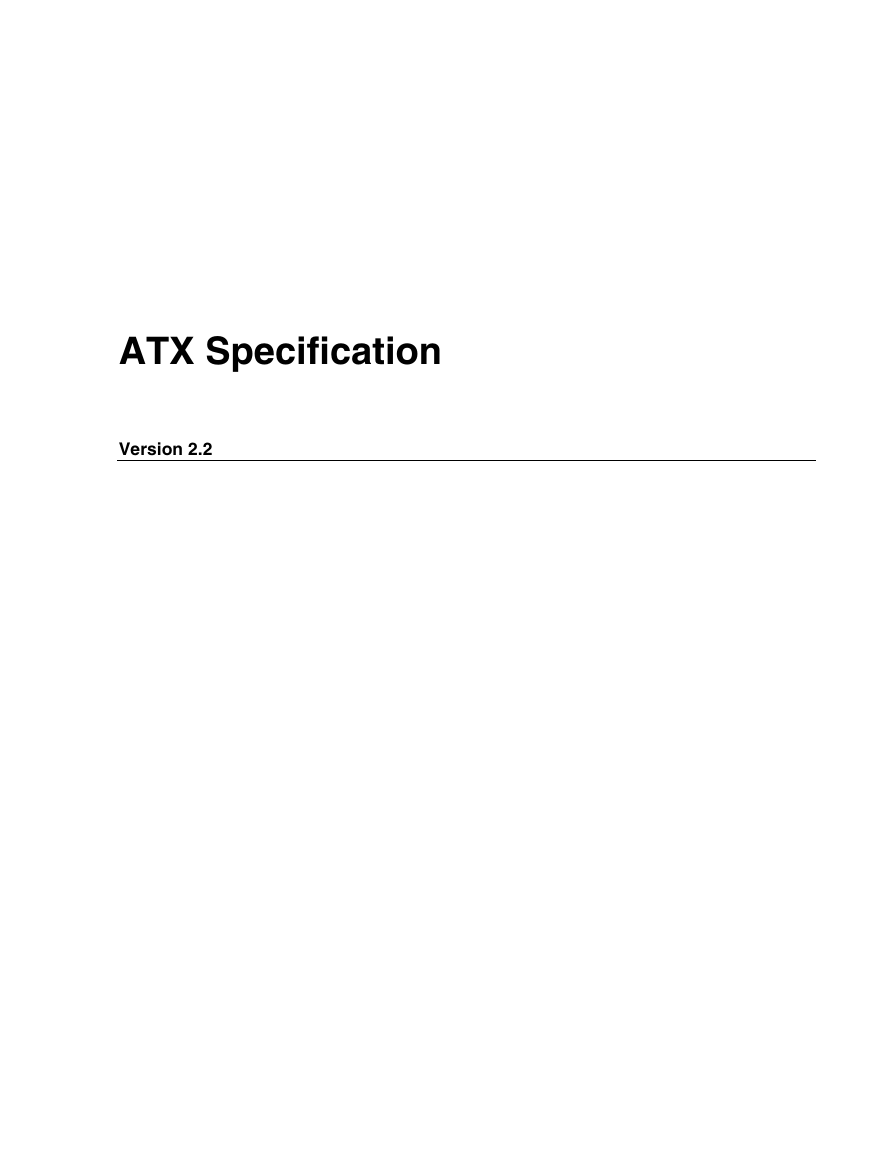
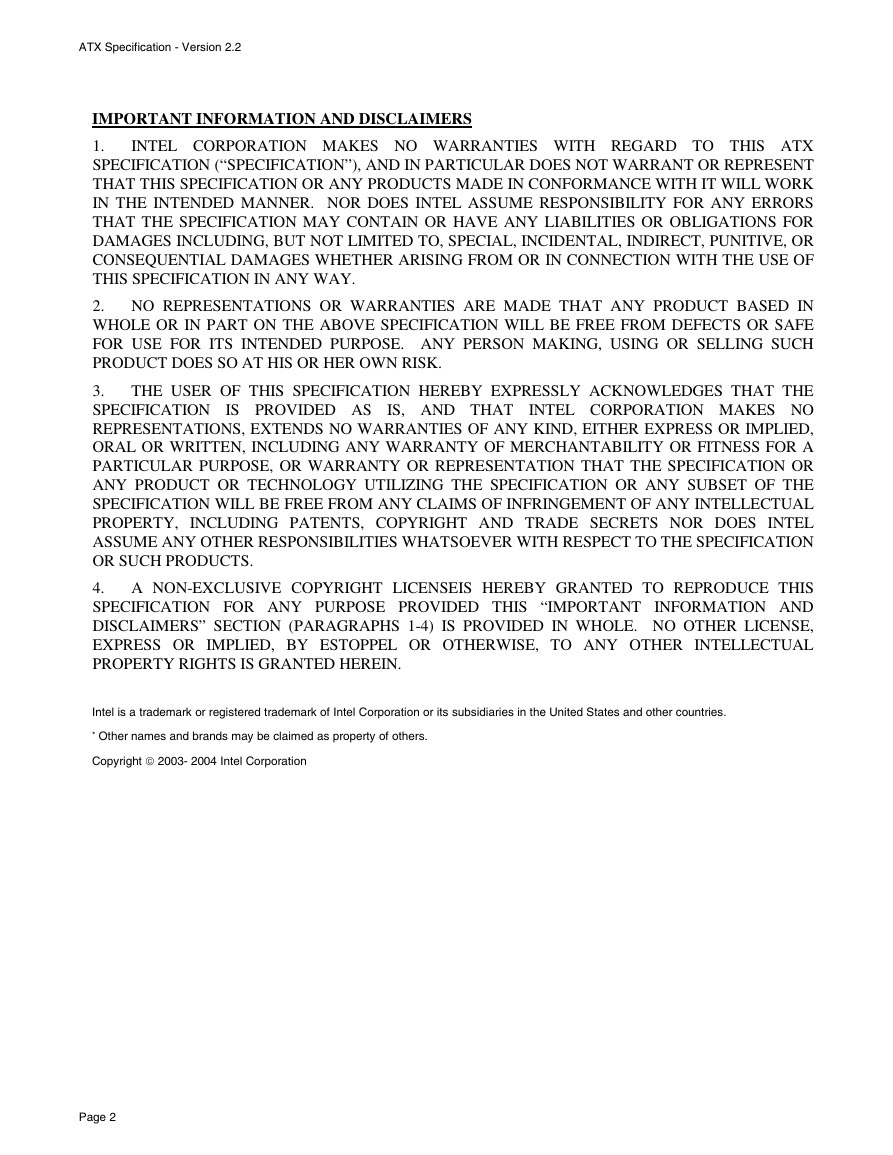
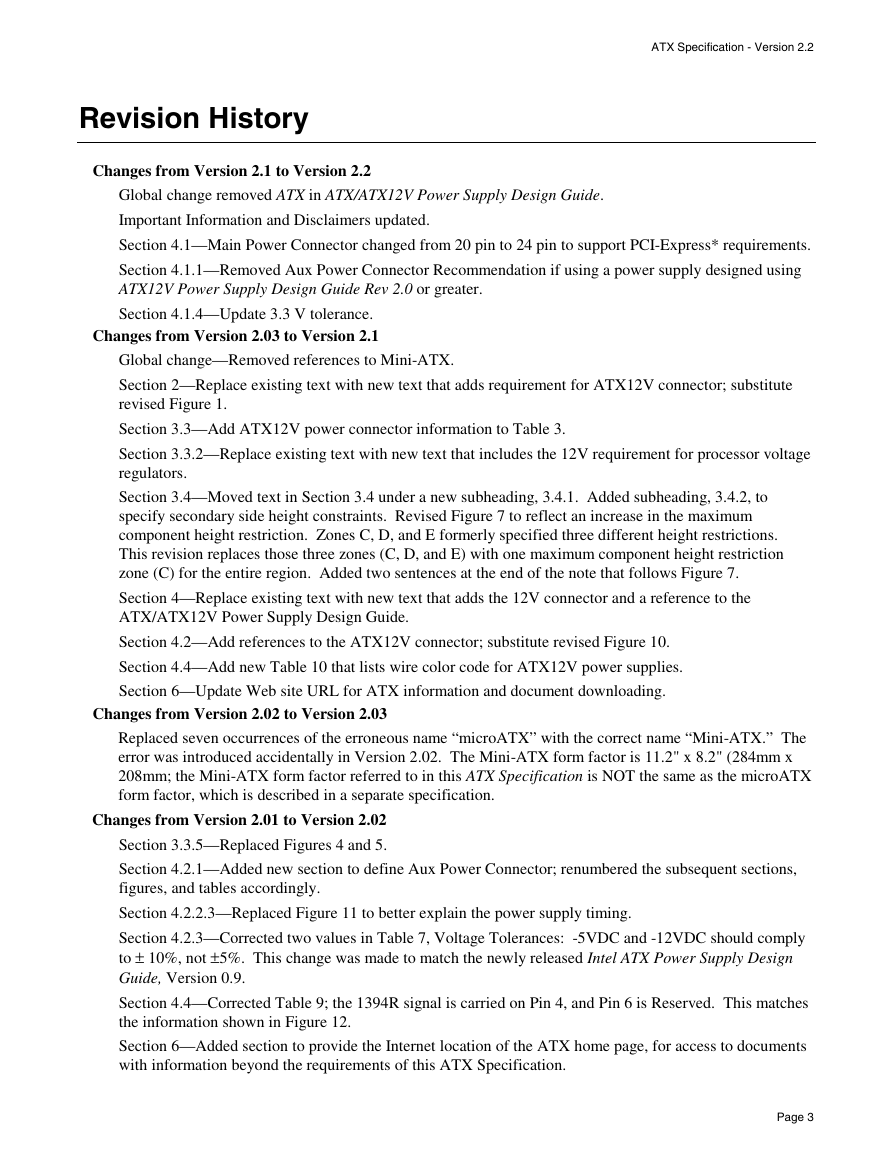
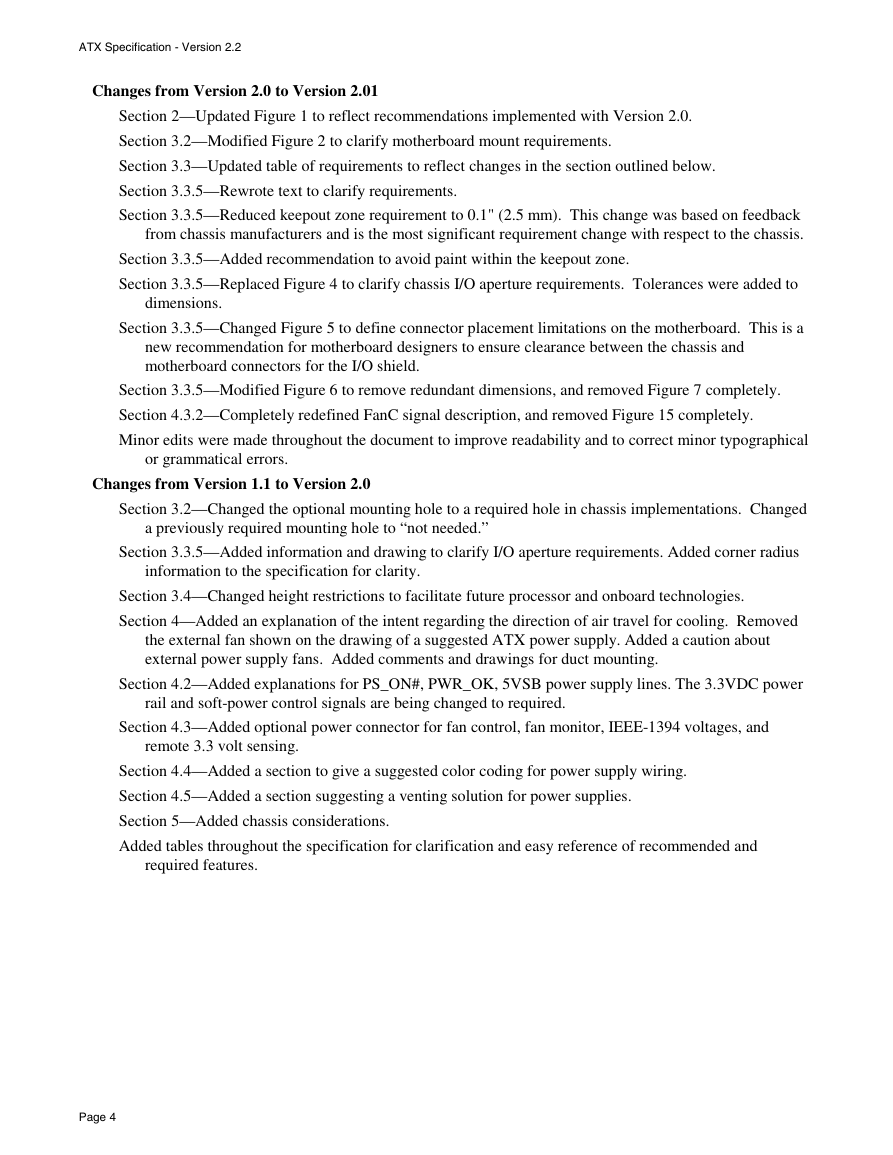
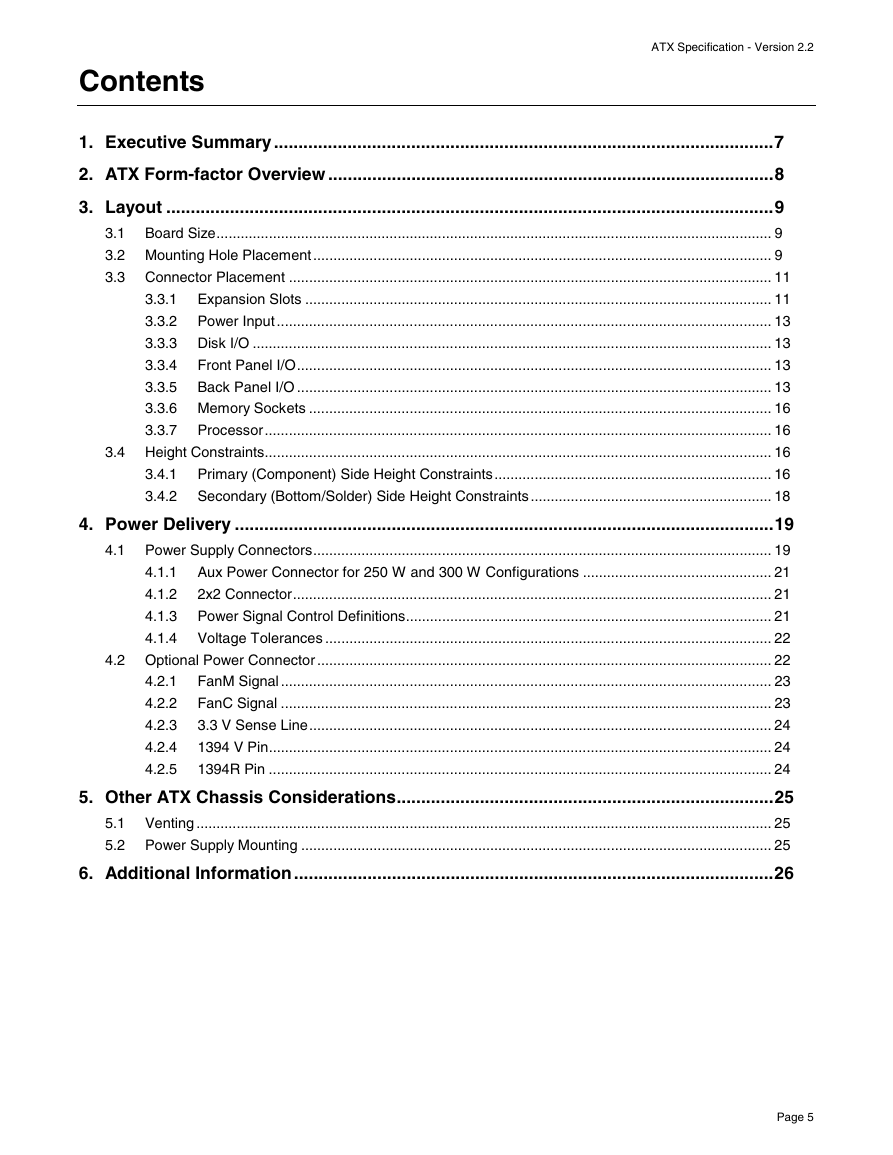
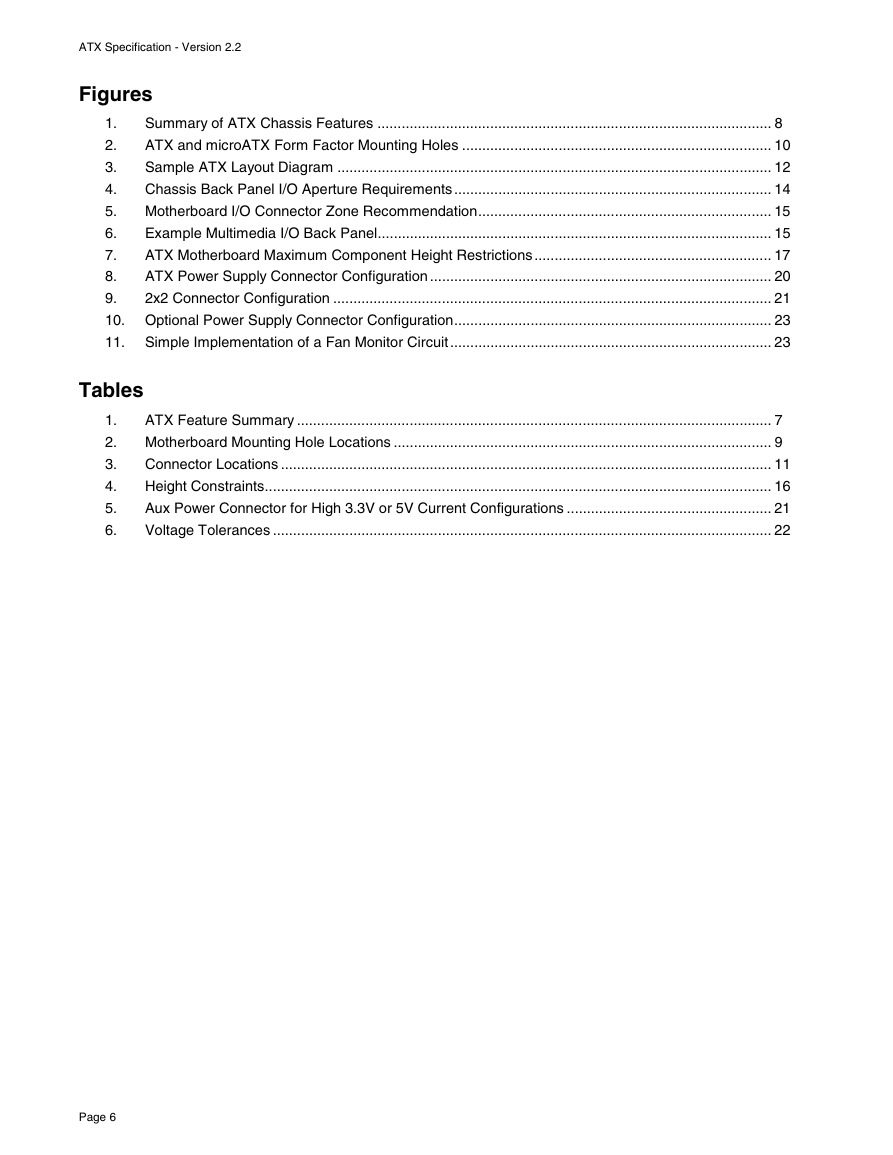
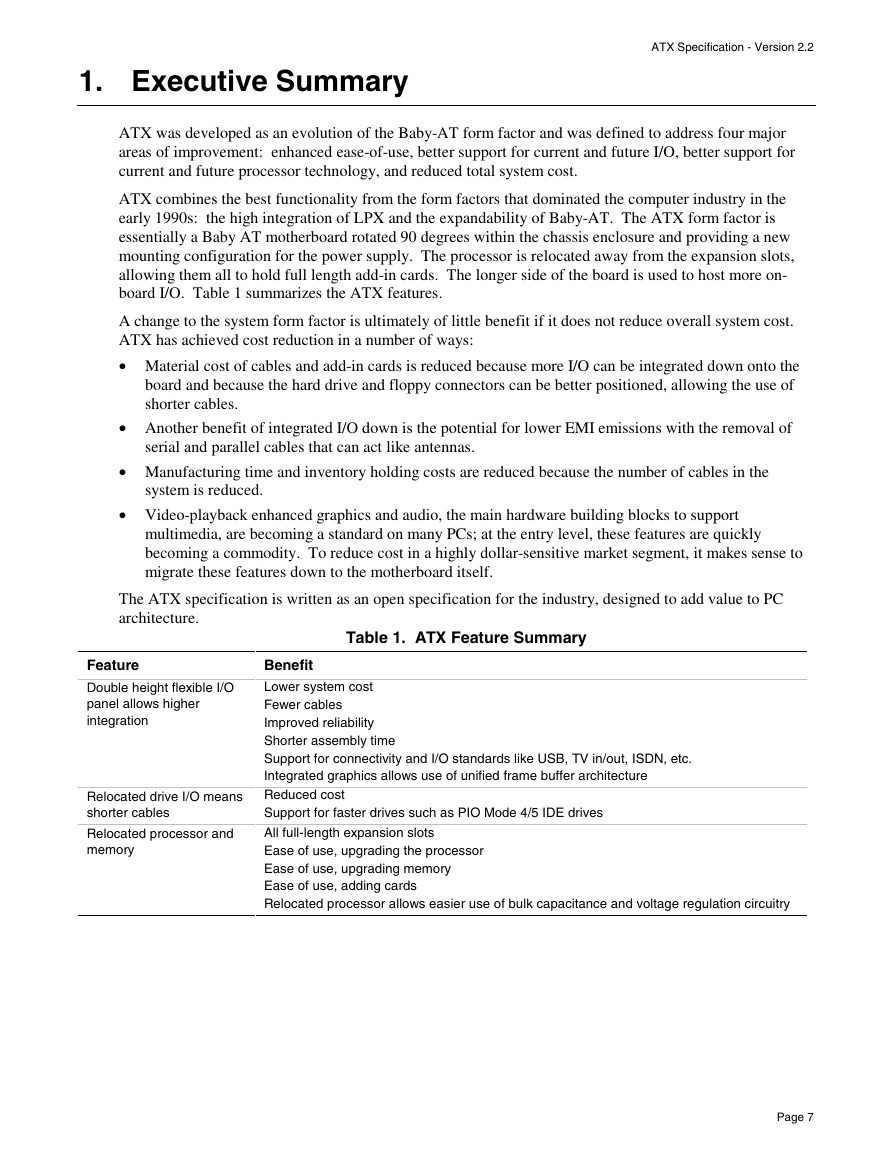
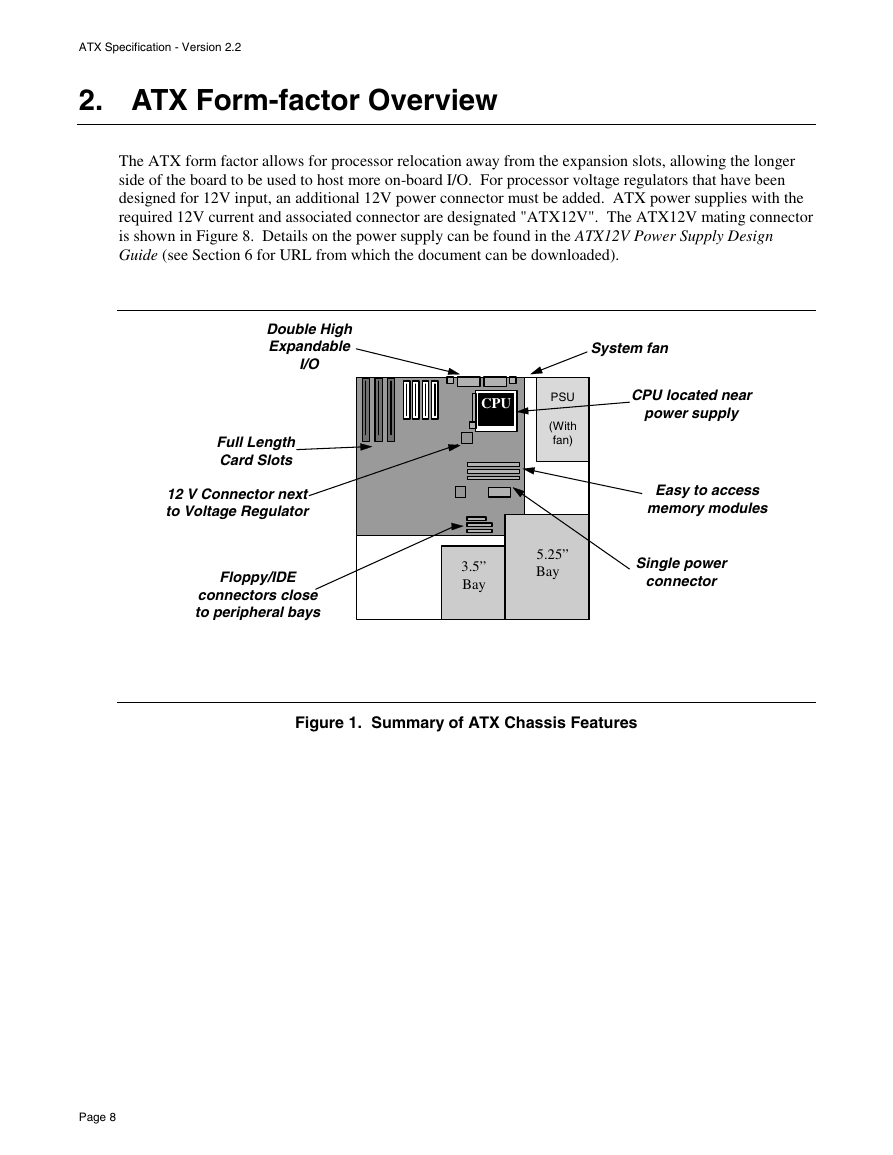








 2023年江西萍乡中考道德与法治真题及答案.doc
2023年江西萍乡中考道德与法治真题及答案.doc 2012年重庆南川中考生物真题及答案.doc
2012年重庆南川中考生物真题及答案.doc 2013年江西师范大学地理学综合及文艺理论基础考研真题.doc
2013年江西师范大学地理学综合及文艺理论基础考研真题.doc 2020年四川甘孜小升初语文真题及答案I卷.doc
2020年四川甘孜小升初语文真题及答案I卷.doc 2020年注册岩土工程师专业基础考试真题及答案.doc
2020年注册岩土工程师专业基础考试真题及答案.doc 2023-2024学年福建省厦门市九年级上学期数学月考试题及答案.doc
2023-2024学年福建省厦门市九年级上学期数学月考试题及答案.doc 2021-2022学年辽宁省沈阳市大东区九年级上学期语文期末试题及答案.doc
2021-2022学年辽宁省沈阳市大东区九年级上学期语文期末试题及答案.doc 2022-2023学年北京东城区初三第一学期物理期末试卷及答案.doc
2022-2023学年北京东城区初三第一学期物理期末试卷及答案.doc 2018上半年江西教师资格初中地理学科知识与教学能力真题及答案.doc
2018上半年江西教师资格初中地理学科知识与教学能力真题及答案.doc 2012年河北国家公务员申论考试真题及答案-省级.doc
2012年河北国家公务员申论考试真题及答案-省级.doc 2020-2021学年江苏省扬州市江都区邵樊片九年级上学期数学第一次质量检测试题及答案.doc
2020-2021学年江苏省扬州市江都区邵樊片九年级上学期数学第一次质量检测试题及答案.doc 2022下半年黑龙江教师资格证中学综合素质真题及答案.doc
2022下半年黑龙江教师资格证中学综合素质真题及答案.doc